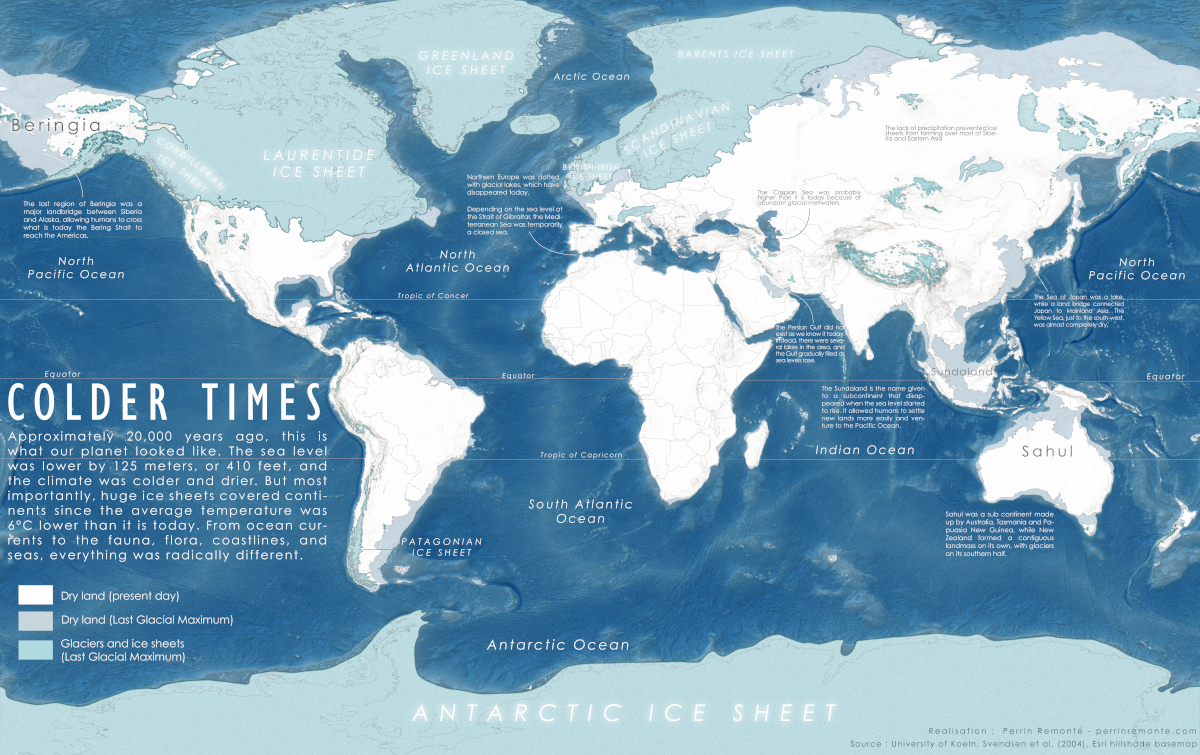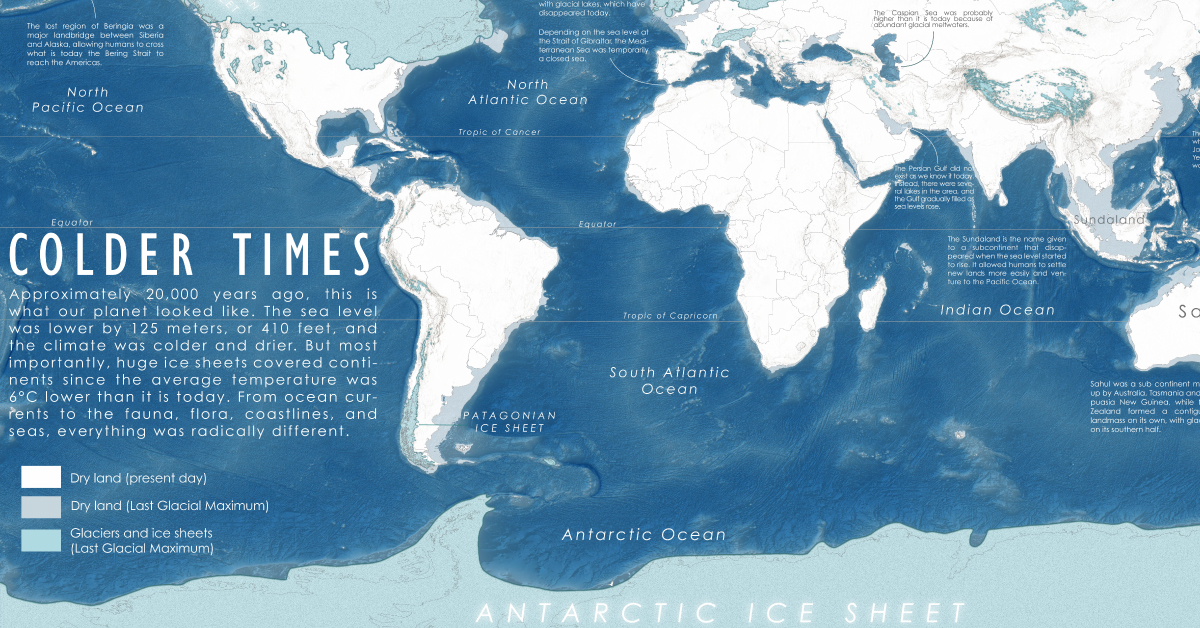Maps
Mapped: What Did the World Look Like in the Last Ice Age?
Click to view this graphic in a higher-resolution.
What Did the World Look Like in the Last Ice Age?
What did the world look like during the last ice age? Was it all endless glaciers and frozen ice? The answer is a partial yes—with some interesting caveats.
The Last Glacial Maximum (LGM), colloquially called the last ice age, was a period in Earth’s history that occurred roughly 26,000 to 19,000 years ago.
This map by cartographer Perrin Remonté offers a snapshot of the Earth from that time, using data of past sea levels and glaciers from research published in 2009, 2014, and 2021, alongside modern-day topographical data.
Let’s dive into the differences between the two Earths below.
The Last Ice Age: Low Seas, Exposed Landmasses
During an ice age, sea levels fall as ocean water that evaporates is stored on land on a large scale (ice sheets, ice caps, glaciers) instead of returning to the ocean.
| Earth's Ice Cover | 20,000 Years Ago | Today |
|---|---|---|
| Surface | 8% | 3% |
| Land | 25% | 11% |
At the time of the LGM, the climate was cold and dry with temperatures that were 6 °C (11 °F) lower on average. Water levels in the ocean were more than 400 feet below what they are now, exposing large areas of the continental shelf.
In the map above, these areas are represented as the gray, dry land most noticeable in a few big patches in Southeast Asia and between Russia and Alaska. Here are a few examples of regions of dry land from 20,000 years ago that are now under water:
- A “lost continent” called Sundaland, a southeastern extension of Asia which forms the island regions of Indonesia today. Some scholars see a connection with this location and the mythical site of Atlantis, though there are many other theories.
- The Bering land bridge, now a strait, connecting Asia and North America. It is central to the theory explaining how ancient humans crossed between the two continents.
- Another land bridge connected the island of Great Britain with the rest of continental Europe. The island of Ireland is in turn connected to Great Britain by a giant ice sheet.
- In Japan, the low water level made the Sea of Japan a lake, and a land bridge connected the region to the Asian mainland. The Yellow Sea—famous as a modern-day fishing location—was completely dry.
The cold temperatures also caused the polar parts of continents to be covered by massive ice sheets, with glaciers forming in mountainous areas.
Flora and Fauna in the Last Ice Age
The dry climate during the last ice age brought about the expansion of deserts and the disappearance of rivers, but some areas saw increased precipitation from falling temperatures.
Most of Canada and Northern Europe was covered with large ice sheets. The U.S. was a mix of ice sheets, alpine deserts, snow forests, semi-arid scrubland and temperate grasslands. Areas that are deserts today—like the Mojave—were filled with lakes. The Great Salt Lake in Utah is a remnant from this time.
Africa had a mix of grasslands in its southern half and deserts in the north—the Sahara Desert existed then as well—and Asia was a mix of tropical deserts in the west, alpine deserts in China, and grasslands in the Indian subcontinent.
Several large animals like the woolly mammoth, the mastodon, the giant beaver, and the saber-toothed tiger roamed the world in extremely harsh conditions, but sadly all are extinct today.
However, not all megafauna from the LGM disappeared forever; many species are still alive, including the Bactrian camel, the tapir, the musk ox, and the white rhinoceros—though the latter is now an endangered species.
Will There Be Another Ice Age?
In a technical sense, we’re still in an “ice age” called the Quaternary Glaciation, which began about 2.6 million years ago. That’s because a permanent ice sheet has existed for the entire time, the Antarctic, which makes geologists call this entire period an ice age.
We are currently in a relatively warmer part of that ice age, described as an interglacial period, which began 11,700 years ago. This geological epoch is known as the Holocene.
Over billions of years, the Earth has experienced numerous glacial and interglacial periods and has had five major ice ages:
| Major Ice Ages | Name | Time Period (Years Ago) |
|---|---|---|
| 1 | Huronian Glaciation | 2.4 billion - 2.1 billion |
| 2 | Cryogenian Glaciation | 720 million - 635 million |
| 3 | Andean-Saharan Glaciation | 450 million - 420 million |
| 4 | Late Paleozoic ice age | 335 million - 260 million |
| 5 | Quaternary Glaciation | 2.6 million - present |
It is predicted that temperatures will fall again in a few thousand years, leading to expansion of ice sheets. However there are a dizzying array of factors that are still not understood well enough to say comprehensively what causes (or ends) ice ages.
A popular explanation says the degree of the Earth’s axial tilt, its wobble, and its orbital shape, are the main factors heralding the start and end of this phenomenon.
The variations in all three lead to a change in how much prolonged sunlight parts of the world receive, which in turn can cause the creation or melting of ice sheets. But these take thousands of years to coincide and cause a significant change in climate.
Furthermore, current industrial activities have warmed the climate considerably and may in fact delay the next ice age by 50,000-100,000 years.

This article was published as a part of Visual Capitalist's Creator Program, which features data-driven visuals from some of our favorite Creators around the world.
Maps
Mapped: The 10 U.S. States With the Lowest Real GDP Growth
In this graphic, we show where real GDP lagged the most across America in 2023 as high interest rates weighed on state economies.

The Top 10 U.S. States, by Lowest Real GDP Growth
This was originally posted on our Voronoi app. Download the app for free on iOS or Android and discover incredible data-driven charts from a variety of trusted sources.
While the U.S. economy defied expectations in 2023, posting 2.5% in real GDP growth, several states lagged behind.
Last year, oil-producing states led the pack in terms of real GDP growth across America, while the lowest growth was seen in states that were more sensitive to the impact of high interest rates, particularly due to slowdowns in the manufacturing and finance sectors.
This graphic shows the 10 states with the least robust real GDP growth in 2023, based on data from the Bureau of Economic Analysis.
Weakest State Economies in 2023
Below, we show the states with the slowest economic activity in inflation-adjusted terms, using chained 2017 dollars:
| Rank | State | Real GDP Growth 2023 YoY | Real GDP 2023 |
|---|---|---|---|
| 1 | Delaware | -1.2% | $74B |
| 2 | Wisconsin | +0.2% | $337B |
| 3 | New York | +0.7% | $1.8T |
| 4 | Missississippi | +0.7% | $115B |
| 5 | Georgia | +0.8% | $661B |
| 6 | Minnesota | +1.2% | $384B |
| 7 | New Hampshire | +1.2% | $91B |
| 8 | Ohio | +1.2% | $698B |
| 9 | Iowa | +1.3% | $200B |
| 10 | Illinois | +1.3% | $876B |
| U.S. | +2.5% | $22.4T |
Delaware witnessed the slowest growth in the country, with real GDP growth of -1.2% over the year as a sluggish finance and insurance sector dampened the state’s economy.
Like Delaware, the Midwestern state of Wisconsin also experienced declines across the finance and insurance sector, in addition to steep drops in the agriculture and manufacturing industries.
America’s third-biggest economy, New York, grew just 0.7% in 2023, falling far below the U.S. average. High interest rates took a toll on key sectors, with notable slowdowns in the construction and manufacturing sectors. In addition, falling home prices and a weaker job market contributed to slower economic growth.
Meanwhile, Georgia experienced the fifth-lowest real GDP growth rate. In March 2024, Rivian paused plans to build a $5 billion EV factory in Georgia, which was set to be one of the biggest economic development initiatives in the state in history.
These delays are likely to exacerbate setbacks for the state, however, both Kia and Hyundai have made significant investments in the EV industry, which could help boost Georgia’s manufacturing sector looking ahead.
-

 Technology1 week ago
Technology1 week agoCountries With the Highest Rates of Crypto Ownership
-

 Mining6 days ago
Mining6 days agoVisualizing Copper Production by Country in 2023
-

 Politics7 days ago
Politics7 days agoCharted: How Americans Feel About Federal Government Agencies
-

 Healthcare1 week ago
Healthcare1 week agoWhich Countries Have the Highest Infant Mortality Rates?
-

 Demographics1 week ago
Demographics1 week agoMapped: U.S. Immigrants by Region
-

 Economy1 week ago
Economy1 week agoMapped: Southeast Asia’s GDP Per Capita, by Country
-

 Automotive1 week ago
Automotive1 week agoHow People Get Around in America, Europe, and Asia
-

 Personal Finance1 week ago
Personal Finance1 week agoVisualizing the Tax Burden of Every U.S. State














